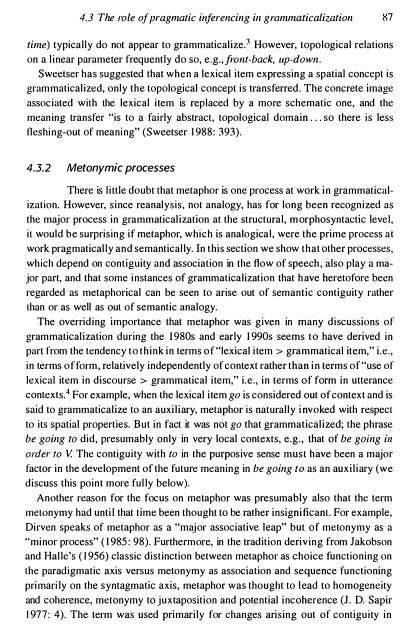Gram - SEAS
Gram - SEAS
Gram - SEAS
You also want an ePaper? Increase the reach of your titles
YUMPU automatically turns print PDFs into web optimized ePapers that Google loves.
4.3 The role of pragmatic inferencing in grammaticalization 87<br />
time) typically do not appear to grammaticalize. 3 However, topological relations<br />
on a linear parameter frequently do so, e.g.,flvnt-back, up-down.<br />
Sweetser has suggested that when a lexical item expressing a spatial concept is<br />
grammaticalized, only the topological concept is transferred. The concrete image<br />
associated with the lexical item is replaced by a more schematic one, and the<br />
meaning transfer "is to a fairly abstract, topological domain ... so there is less<br />
fleshing-out of meaning" (Sweetser 1988: 393).<br />
4.3.2 Metonymic processes<br />
There is little doubt that metaphor is one process at work in grammaticalization.<br />
However, since reanalysis, not analogy, has for long been recognized as<br />
the major process in grammaticalization at the structural, morphosyntactic level,<br />
it would be surprising if metaphor, which is analogical, were the prime process at<br />
work pragmatically and semantically. In this section we show that other processes,<br />
which depend on contiguity and ·association in the flow of speech, also play a major<br />
part, and that some instances of grammaticalization that have heretofore been<br />
regarded as metaphorical can be seen to arise out of semantic contiguity rather<br />
than or as well as out of semantic analogy.<br />
The overriding importance that metaphor was given in many discussions of<br />
grammaticalization during the 1980s and early 1990s seems to have derived in<br />
part from the tendency to think in terms of "lexical item > grammatical item," i.e.,<br />
in terms ofform, relatively independently of context rather than in terms of "use of<br />
lexical item in discourse > grammatical item," i.e., in terms of form in utterance<br />
contexts. 4 For example, when the lexical item go is considered out of context and is<br />
said to grammaticalize to an auxiliary, metaphor is naturally invoked with respect<br />
to its spatial properties. But in fact it was not go that grammaticalized; the phrase<br />
be going to did, presumably only in very local contexts, e.g., that of be going ill<br />
order to V. The contiguity with to in the purposive sense must have been a major<br />
factor in the development of the future meaning in be going to as an auxiliary (we<br />
discuss this point more fully below).<br />
Another reason for the focus on metaphor was presumably also that the term<br />
metonymy had until that time been thought to be rather insigni ficant. For example,<br />
Dirven speaks of metaphor as a "major associative leap" but of metonymy as a<br />
"minor process" (1985: 98). Furthermore, in the tradition deriving from lakobson<br />
and Halle's (1956) classic distinction between metaphor as choice fu nctioning on<br />
the paradigmatic axis versus metonymy as association and sequence functioning<br />
primarily on the syntagmatic axis, metaphor was thought to lead to homogeneity<br />
and coherence, metonymy to juxtaposition and potential incoherence (J. D. Sapir<br />
1977: 4). The term was used primarily for changes arising out of contiguity in
















